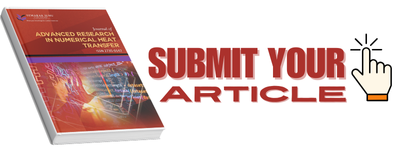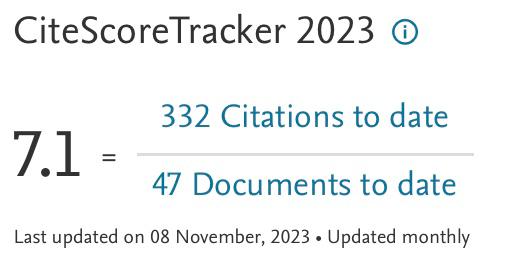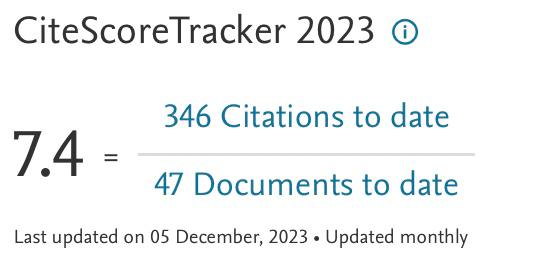Effect of Septum Deviation on the Airflow Distribution for a Patient Specific Model using Numerical Methods
DOI:
https://doi.org/10.37934/arnht.14.1.4957Keywords:
Septal deviation, Nasal cavity, Turbulence Flow, RANS Model, Wall shear stress, ANSYS FluentAbstract
Septal deviation (SD) in nasal cavity plays a crucial role in symptoms related to nasal obstruction, aesthetic appearance of the nose, and increase in nasal resistance, and may induce snoring. The aim of the present study was to evaluate the significance of SD on the air flow behaviour and compare its deviation with a healthy nasal cavity by using CFD. A 3D CAD model of subject specific nasal cavity was generated from CT images of patient with septal deviation. The variation of maximum WSS observed in the present study was higher when compared with that of normal subjects. In contrast to the healthy subject, the airflow in the septal deviation models showed asymmetry in bilateral nasal cavities. The maximum velocity inside the nasal cavity exceeded the value that was usually found at the nasal valve region. The findings from this study help understand the basic aerodynamics in a severely deviated septum.
Downloads
References
Gupta, Neelima, P. P. Singh, and Rahul Kumar Bagla. "Will septal correction surgery for deviated nasal septum improve the sense of smell? A prospective study." Surgery Research and Practice 2015 (2015). https://doi.org/10.1155/2015/496542
Fyrmpas, G., M. Tsalighopoulos, and J. Constantinidis. "Lateralized olfactory difference in patients with a nasal septal deviation before and after septoplasty." Hippokratia 16, no. 2 (2012): 166.
Leopold, Donald A. "The relationship between nasal anatomy and human olfaction." The Laryngoscope 98, no. 11 (1988): 1232-1238. https://doi.org/10.1288/00005537-198811000-00015
Teixeira, Jeffrey, Victor Certal, Edward T. Chang, and Macario Camacho. "Nasal septal deviations: a systematic review of classification systems." Plastic surgery international 2016 (2016). https://doi.org/10.1155/2016/7089123
Li, Lifeng, Hongrui Zang, Demin Han, Murugappan Ramanathan Jr, Ricardo L. Carrau, and Nyall R. London Jr. "Impact of a concha bullosa on nasal airflow characteristics in the setting of nasal septal deviation: a computational fluid dynamics analysis." American journal of rhinology & allergy 34, no. 4 (2020): 456-462. https://doi.org/10.1177/1945892420905186
Frank-Ito, Dennis O., Julia S. Kimbell, Azadeh AT Borojeni, Guilherme JM Garcia, and John S. Rhee. "A hierarchical stepwise approach to evaluate nasal patency after virtual surgery for nasal airway obstruction." Clinical biomechanics 61 (2019): 172-180. https://doi.org/10.1016/j.clinbiomech.2018.12.014
Pfaar, O., K. B. Hüttenbrink, and T. Hummel. "Assessment of olfactory function after septoplasty: a longitudinal study." Rhinology 42, no. 4 (2004): 195-199.
Zubair, Mohammed, Mohammed Zulkifly Abdullah, Rushdan Ismail, Ibrahim Lutfi Shuaib, Suzina Abdul Hamid, and Kamarul Arifin Ahmad. "A critical overview of limitations of CFD modeling in nasal airflow." Journal of Medical and Biological Engineering 32, no. 2 (2012): 77-84.
Zubair, Mohammed, Kamarul Arifin Ahmad, Mohd Zulkifly Abdullah, and Shaker Farid Sufian. "Characteristic airflow patterns during inspiration and expiration: Experimental and numerical investigation." Journal of medical and biological engineering 35 (2015): 387-394. https://doi.org/10.1007/s40846-015-0037-4
Zhao, Kai, Jianbo Jiang, Edmund A. Pribitkin, Pamela Dalton, David Rosen, Brian Lyman, Karen K. Yee, Nancy E. Rawson, and Beverly J. Cowart. "Conductive olfactory losses in chronic rhinosinusitis? A computational fluid dynamics study of 29 patients." In International forum of allergy & rhinology, vol. 4, no. 4, pp. 298-308. 2014. https://doi.org/10.1002/alr.21272
Riazuddin, Vizy Nazira, Mohammed Zubair, Milad Ahmadi, Masaaki Tamagawa, Nur Hashima Abdul Rashid, Norkhairunnisa Mazlan, and Kamarul Arifin Ahmad. "Computational fluid dynamics study of airflow and microparticle deposition in a constricted pharyngeal section representing obstructive sleep apnea disease." Journal of Medical Imaging and Health Informatics 6, no. 6 (2016): 1507-1512. https://doi.org/10.1166/jmihi.2016.1839
Mylavarapu, Goutham, Shanmugam Murugappan, Mihai Mihaescu, Maninder Kalra, Sid Khosla, and Ephraim Gutmark. "Validation of computational fluid dynamics methodology used for human upper airway flow simulations." Journal of biomechanics 42, no. 10 (2009): 1553-1559. https://doi.org/10.1016/j.jbiomech.2009.03.035
Riazuddin, Vizy Nazira, Mohammed Zubair, Mohammed Zulkifly Abdullah, Rushdan Ismail, Ibrahim Lutfi Shuaib, Suzina Abdul Hamid, and Kamarul Arifin Ahmad. "Numerical study of inspiratory and expiratory flow in a human nasal cavity." Journal of Medical and Biological Engineering 31, no. 3 (2011): 201-206.
Zubair, Mohammed, Vizy Nazira Riazuddin, Mohammed Zulkifly Abdullah, Rushdan Ismail, Ibrahim Lutfi Shuaib, and Kamarul Arifin Ahmad. "Computational fluid dynamics study of the effect of posture on airflow characteristics inside the nasal cavity." Asian Biomedicine 7, no. 6 (2013): 835-840.
O'REILLY, B. J., D. C. Simpson, and R. Dharmeratnam. "Recurrent epistaxis and nasal septal deviation in young adults." Clinical Otolaryngology & Allied Sciences 21, no. 1 (1996): 12-14. https://doi.org/10.1111/j.1365-2273.1996.tb01017.x
Wen, Jian, Kiao Inthavong, Jiyuan Tu, and Simin Wang. "Numerical simulations for detailed airflow dynamics in a human nasal cavity." Respiratory physiology & neurobiology 161, no. 2 (2008): 125-135. https://doi.org/10.1016/j.resp.2008.01.012
Radulesco, Thomas, Lionel Meister, Gilles Bouchet, Arthur Varoquaux, Jérome Giordano, Julien Mancini, Patrick Dessi, Pierre Perrier, and Justin Michel. "Correlations between computational fluid dynamics and clinical evaluation of nasal airway obstruction due to septal deviation: An observational study." Clinical otolaryngology 44, no. 4 (2019): 603-611. https://doi.org/10.1111/coa.13344
Deviated Septum (2021). American academy of otolaryngology-head and neck surgery.
Borojeni, Azadeh AT, Guilherme JM Garcia, Masoud Gh Moghaddam, Dennis O. Frank-Ito, Julia S. Kimbell, Purushottam W. Laud, Lisa J. Koenig, and John S. Rhee. "Normative ranges of nasal airflow variables in healthy adults." International journal of computer assisted radiology and surgery 15 (2020): 87-98. https://doi.org/10.1007/s11548-019-02023-y
Hildebrandt, Thomas, Jan Joris Bruening, Nora Laura Schmidt, Hans Lamecker, Werner Heppt, Stefan Zachow, and Leonid Goubergrits. "The Healthy Nasal Cavity—Characteristics of Morphology and Related Airflow Based on a Statistical Shape Model Viewed from a Surgeon's Perspective." Facial Plastic Surgery 35, no. 01 (2019): 009-013. https://doi.org/10.1055/s-0039-1677721



























